Software zoom has been a thing since the dawn of smartphone imaging - think 2006 or so. Zoom functions were put into camera application interfaces, even though all the zooming achieved was to enlarge the existing pixel data, making zoomed photos recognisable (and pointless) because of the blocky appearance. The common wisdom at the time was 'never zoom' as you didn't really gain anything.
And, despite outlier phones like the super-bulky Nokia N93, with genuine 'moving parts' optical (3x) zoom, things stayed much the same for the next six years - avoid digital zoom, since results just get ugly.
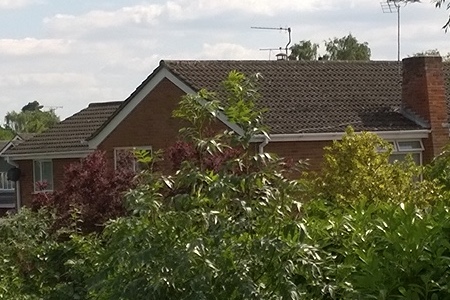
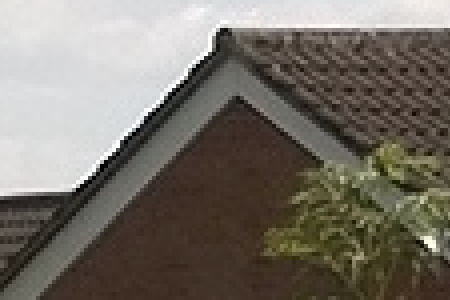
Digital zoom example, note the jagged edges and ultra-blocky greenery
Then, in 2012, everything changed. Firstly Nokia announced the 808 PureView, with giant 41MP 1/1.2" sensor, with the premise that zooming could be done digitally by 'smart cropping' into that sensor in such a way that even at 2.5x zoom the resulting 5MP photos were still representing what the sensor saw at the pixel level, i.e. there was no guesswork involved in making up or enlarging detail. This 'PureView zoom' system made its way into 2013's Lumia 1020, which added OIS for low light use, and that's the implementation tested here.

Also in 2012 was another break through in digital zoom, I'd argue, this time over at Samsung, where camera app developers started putting actual intelligence into how digital zooming was done - so on the Galaxy Note II's camera, if you zoomed in by 2x then you got 'interpolated' detail, with algorithms making intelligent guesses as to pixel values between the real data points. This worked superbly at 2x and was still usable at 3x.


Example of intelligent interpolative zoom at 3x...
Subsequent Samsungs and the rest of the industry followed suit, with interpolative zoom being the cheap and relatively easy way to digitally zoom in phone cameras. Until 2016 when phones (the first I can remember is the iPhone 7 Plus) started to come with a second, dedicated 2x 'telephoto' lens, relying on clever software to handle the transition from the main 1x lens to the telephoto and then do interpolative zoom above 2x. This category, now widespread, is represented here by my trusty Samsung Galaxy S9+.

In the last year or so we've seen the rise of high megapixel sensors and smart cropping again, albeit in a slightly cruder way than Nokia's original PureView system in terms of pixel combination. Groups of four pixels are simply combined, digitally, averaging out noise but not really helping in terms of being able to resolve detail, especially when you start zooming in, since getting to the pixel level involves sacrifices in terms of both luminance and colour accuracy. In Huawei's example, used here, from the P30 Pro, there's OIS (just as on the original Lumia 1020) and there's also a new RYYB colour arrangement which, in theory, is more light sensitive.
Also in the last year, we've seen yet another new zoom technique, invented by Google, wherein multiple exposures at (a cropped) standard resolution and 1x zoom are taken and then the software uses tha fact that your hands are never entirely steady to use the minute wobbling of the phone camera's position and angle to good effect. Essentially, each of the exposures is slightly differently framed during the fraction of a second of the shot and software can ascertain the differences at the pixel level and merge the images together in a way that 'fills in detail' beyond the physical capability of the sensor. Clever. This approach is illustrated below by the Pixel 3 XL.

So, a variety of approaches and I wanted to illustrate what they can do with some real world examples. Note that this ISN'T a camera phone test in the usual way, I'm not trying to claim one device is better than another, but I am trying to evaluate which zoom technique is best, overall.
Why not 5x?
At this point, someone's going to pop up their hand and ask "So why are you ignoring the P30 Pro's 5x telephoto lens, one of its USPs?" Good question. I've tested the P30 Pro a lot and, while it's superb for demonstrating extreme zooms, shooting a duck at 50m, for example, it's not that useful for everyday subjects. You see, tapping on the 5x control in the interface immediately gets you five times closer to the subject, optically (and obviously), but this is usually too close.
For example, you're snapping some friends in front of some tourist attraction - they're about five metres away and nicely framed against the backdrop. So you take a photo and then decide to get a bit closer, in on the people rather than taking in the whole landscape. So you go to 5x zoom and all of a sudden you're struggling to even squeeze the group of people in the frame. What's needed here - and surprisingly often in real life, in my experience, is a really good 2x or 3x zoom capability.
In theory, the likes of the P30 Pro's main 40MP sensor can provide 2x lossless digital zoom at 10MP, in roughly the same way as the sensor on that old Lumia 1020 worked. Plus it has the modern interpolative (are we allowed to say 'AI-powered'?) software zoom as well, to aid going to 3x, and so it should do pretty well.
Throwing the Lumia 1020 into the mix does introduce a resolution disparity, since it's outputting 5MP, so the full PureView zooming is equivalent to about 2x at 8MP and the software won't allow digital zoom beyond this. But you'll get a feel for how well (or badly) it does in the graphical comparisons below.
The S9+ and Pixel 3 XL below use their 2x telephoto and multi-exposure zoom tech 'as is', in somewhat simpler fashion, but both approaches have a lot to recommend them.
Test 1: The playground
A typical subject, minus your kids - for obvious reasons you only get the equipment here! So you're at the playground and they're playing happily, about five metres away. A snap from 5m is a bit too general, a 5x zoom lens would mean you'd only get a face and an elbow and no context. So what's needed is a typical 2x or 3x zoom on your camera phone. Here's the full unzoomed scene, just imagine your kids playing on it and you're there:
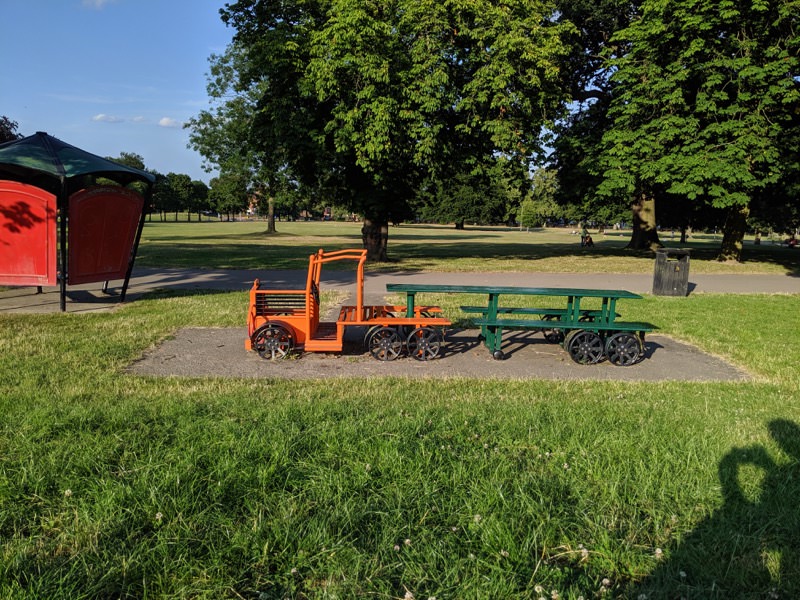
I then zoomed in by a factor of two on each test smartphone (tech). The Lumia 1020 went to 2.5x, but that works out to about 2x with the more modern hardware and higher output resolutions, so the cropped zoom photos do match up. Here they are from, in order, the Lumia 1020, Huawei P30 Pro, Pixel 3 XL, and Galaxy S9+, click their links to download the original JPGs for your own analysis if you like:
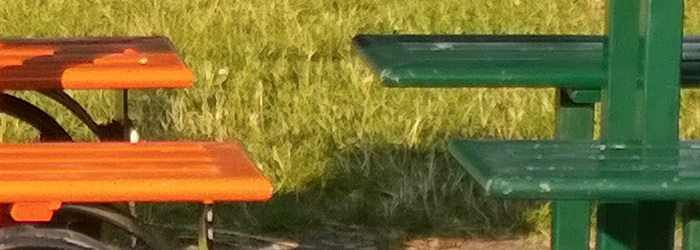

![]()
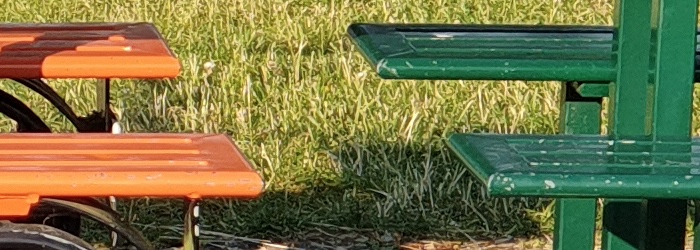
All four zoom technologies do well here, to be honest. The Galaxy S9's telephoto lens takes the win by a nose, being clearer and more detailed, while the Lumia 1020 and P30 Pro aren't far behind, with lossless smart cropping into their similar resolution sensors, the 1020's result looks purer but less sharp, the P30 Pro's the other way round. But they're in the same league, as you'd expect. The Pixel's multi-exposure zoom is definitely in fourth place, with a wooliness to detail that's actually disappointing, given Google's software prowess.
I wanted to go further though, and push the zoom systems further than 2x - what if you needed 3x for your photo? None of these systems support 3x exactly, so it's starting to come down to combinations of hardware and software. And I have to - reluctantly, this being AAWP - exclude the Lumia 1020, since its interface doesn't allow for any interpolative, software-aided zoom.
So I shot the same scene, but zoomed at 3x, or as close as I could get in the camera UIs. Here they are from, in order, the Huawei P30 Pro, Pixel 3 XL, and Galaxy S9+, click their links to download the original JPGs for your own analysis if you like:
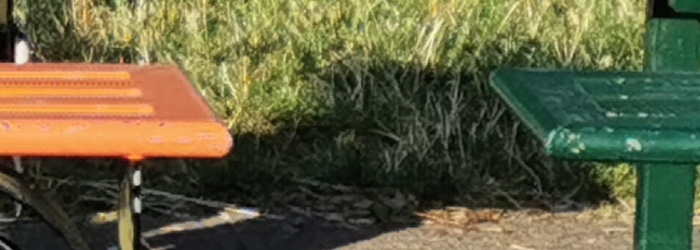
![]()
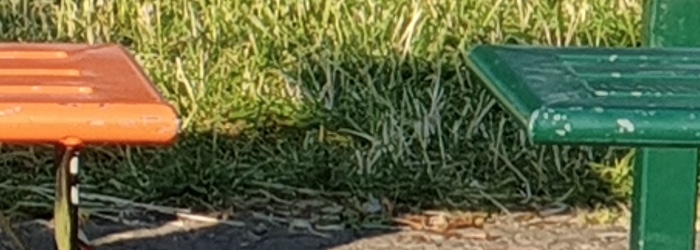
Artefacts are now the order of the day, as you might expect, down at the pixel level. The P30 Pro takes this test with surprisingly smooth 3x zoom, and perhaps showing what a 'modern day Lumia 1020' could achieve. A clever combination of hardware and software. The S9+ applies some interpolative zoom to the 2x telephoto snap, but the image processing goes a bit overboard in terms of sharpening. The software-only approach of the Pixel 3 XL fares worse, with detail being rather ugly at 3x - again, I'd have expected better from Google.
Test 2 - the Blade
Lit by the sun rather attractively, one of the features of Reading's skyline. This is more of a technical test, with more regular detail to look at. And yes, if I was going for absolute zoom then the P30 Pro's 5x telephoto would ace this. But remember, I'm testing just its main sensor and 'PureView' zoom in this feature, pitched against other 2x and 3x zoom tech - this is a scientific test. Here's the full unzoomed scene, for context:

I then zoomed in by a factor of two on each test smartphone (tech). The Lumia 1020 went to 2.5x, but that works out to about 2x with the more modern hardware and higher output resolutions, so the cropped zoom photos do match up. Here they are from, in order, the Lumia 1020, Huawei P30 Pro, Pixel 3 XL, and Galaxy S9+, click their links to download the original JPGs for your own analysis if you like:
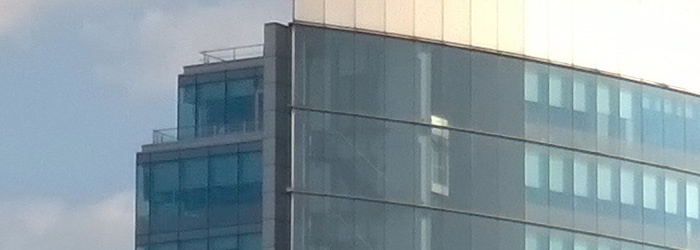
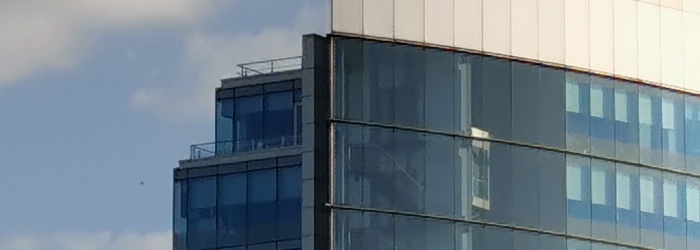
![]()
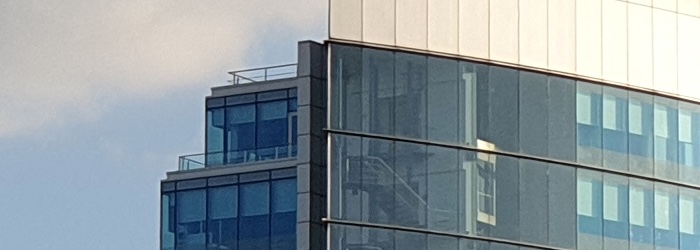
The ranking is pretty much the same as with the playground shot - the optical 2x lens in the S9+ produces the clearest and most detailed shot, just look at the staircase in the crop - you can make out all the individual stairs! Again the P30 Pro and Lumia 1020 are second, some way behind, with the newer sensor tech and increased processing power in the much newer P30 Pro making a big difference in terms of contrast. And again the 'jiggle the framing and use software' approach of the Google Pixel produces something which really should be clearer, especially with all the lines and straight edges for the algorithms to latch onto.
Again, I wanted to go further though, and push the zoom systems to 3x. Again, I have to - reluctantly, this being AAWP - exclude the Lumia 1020, since its interface doesn't allow for any interpolative, software-aided zoom.
So I shot the same scene, but zoomed at 3x, or as close as I could get in the camera UIs. Here they are from, in order, the Huawei P30 Pro, Pixel 3 XL, and Galaxy S9+, click their links to download the original JPGs for your own analysis if you like:
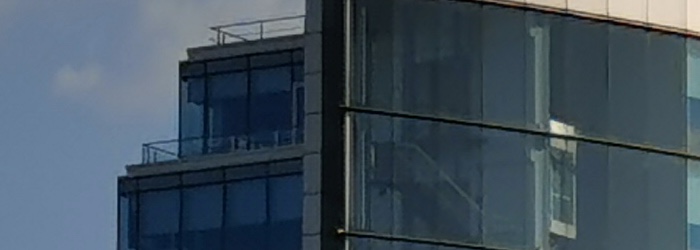
![]()
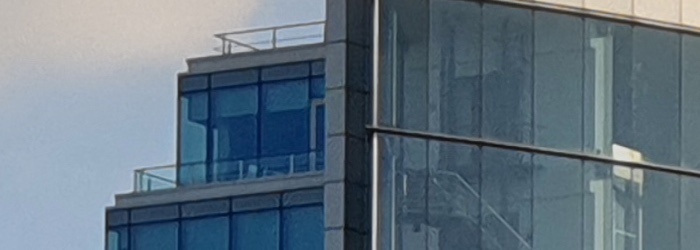
The telephoto plus software zoom approach of the S9+ does better here than in the platground shot, thanks to all the straight edges. But the P30 Pro's closer, with its extreme smart crop into its 40MP sensor, even if there are more artefacts than in the Galaxy S9+ shot. And, again, the 'Super HiRes Zoom' (trademark Google) approach comes in plumb last. And this is with a year of updates. Oh well.
Conclusions
In conclusion, and rather obviously(!), I think Nokia were onto something with PureView zoom. The modern implementation here on the Huawei P30 Pro is pretty much spot on, with the latter's 5x telephoto to take over above 5x zoom. It does mean that results at 3x and 4x aren't any better than a 2x telephoto approach plus interpolative zoom, but at least they're not worse. And the P30 Pro has that extra dimension to take off into. There are still glitches as the P30 Pro switches between its various lenses, but perhaps continued software updates can improve this...
But the typical 'twin camera, main plus 2x' approach of the S9+ (common to the Note 9 and copied by many iPhones and cheaper Android phones) is a good all round solution when needing just 2x and 3x zoom, rather obviously. Day to day zoomed shots rather than extreme tests. No real surprises here. And it's why my main, personal smartphone (outside of Windows) has been the Galaxy S9+ now for over a year. The camera is a darned good all rounder, zooming enough where needed and keeping things simple.
The Google Pixel camera is disappointing though - they claimed that their software approach 'got close' to 2x telephoto systems, but it doesn't, as you can see above. In fact, I'd say it's barely better than ye olde interpolative zoom. Oh well, there's always the Pixel 4 with multiple cameras, supposed to come in a few months.
The Lumia 1020 does very well at 2x, as you might expect, amazingly well for a six year old smartphone (arguably with 13 year old imaging tech), but its results are starting to show the age of its sensor and limited processing power in terms of clarity and contrast.
Comments welcome - how often do you zoom in casual shots and do you ever get close to, or exceed, 5x?
